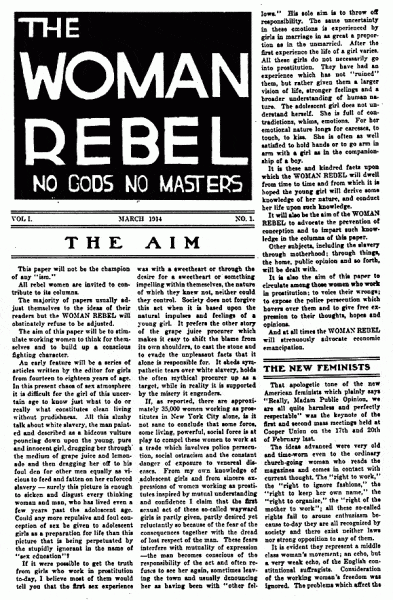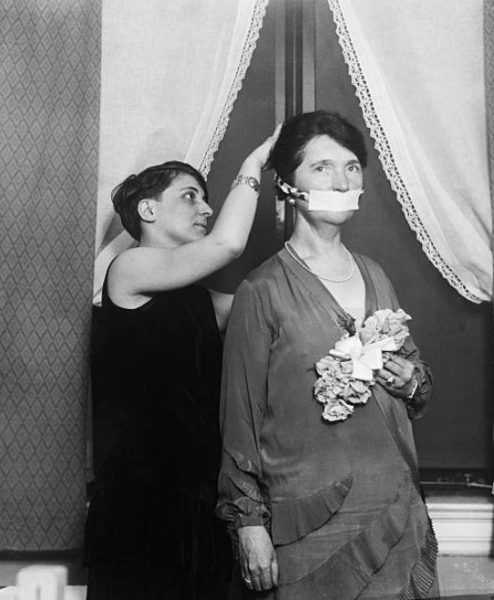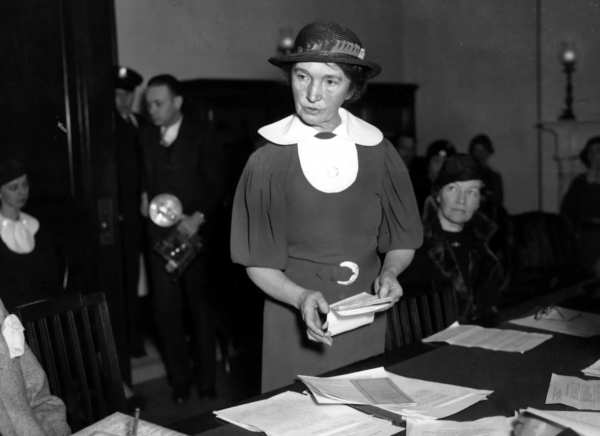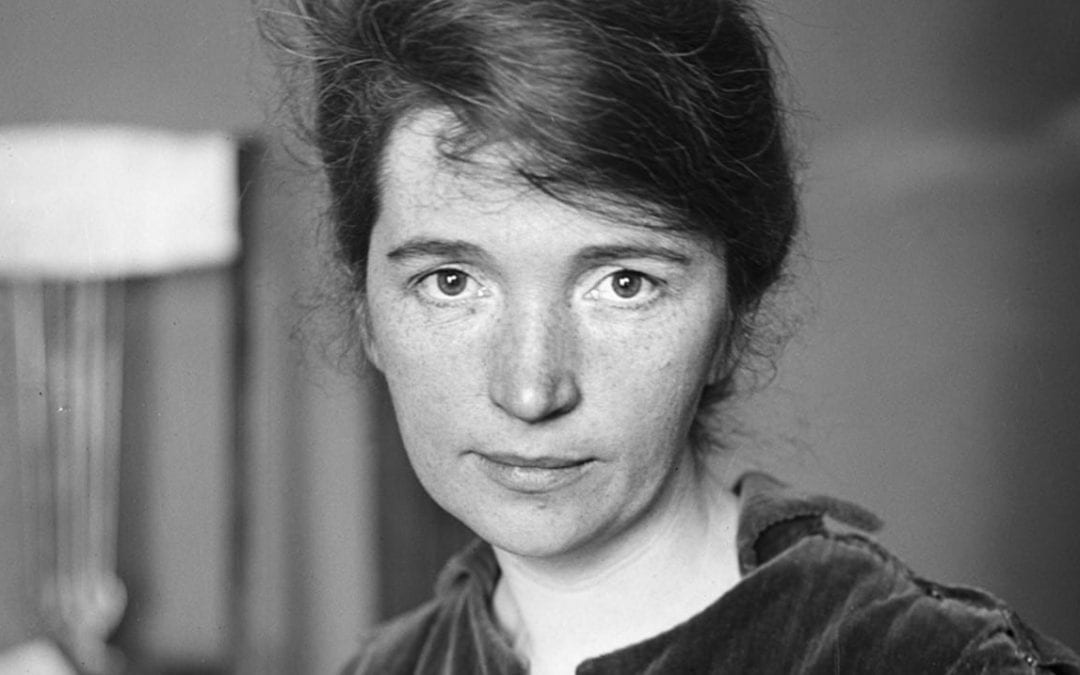Sexuality in the United States of America is not the same as seen in the 1800s. Today, a large proportion of women in the country begin utilizing a form of contraception at a young age in order to enjoy the pleasures of sex without worrying about having to halt one’s education or career in order to be a mother. However, in the 1800s and early 1900s, usage of contraceptives was far less common due to laws prohibiting the distribution of contraceptives or simply information about contraceptives via mail or in other non-approved settings. Margaret Sanger sought to change this. Margaret Sanger is largely renowned for her work as an ambitious feminist leading the birth control revolution in America and, largely, around the world. However, Sanger’s motivations behind this work had dark roots in racism and eugenics, demonstrating the importance of acknowledging the dangerous rhetoric of her work and how it may have impacted social groups around her.

Sanger’s publication “The Woman Rebel”
Source: https://sangerpapers.wordpress.com/2014/03/20/margaret-sangers-the-woman-rebel-100-years-old/
Sanger’s childhood and early adulthood are said to have largely shaped her passion towards helping women obtain methods of birth control. Born in 1879, Sanger was raised in a family of eleven children, which resulted in a childhood largely shaped by her mother’s life as a stressed and overworked mother[1]. In her early adulthood, Sanger became a nurse in New York, a career that opened her eyes to the struggles women without access to birth control faced due to unplanned and ill-equipped pregnancies. In her autobiography, Sanger recalled numerous occasions in which women came to her, seeking a way to avoid or prevent pregnancies. In one instance, a woman asked, “Miss Higgins, [Mrs. Sanger] what should I do not to have another baby right away?”[2]. In another instance, a woman had several miscarriages and six children, each with a different father [3]. While doctors and nurses knew that she would likely return again with pregnancy-related health issues, they did nothing about it because pregnancy and its related issues were deemed to be “natural” and therefore did not require a method of prevention [4]. As such, despite the numerous complaints, most of the issues regarding young women and pregnancy were either dismissed by doctors, or doctors were unable to help due to the Comstock Laws [5]. The Comstock Act of 1873 made it illegal to publish, distribute, and possess obscene information, which included information about medications or other methods of abortion and contraception [6]. Therefore, the United States of America in the 1800s and early 1900s was a place in which contraceptives use and distribution was largely limited and criminalized.
This criminalization of widespread birth control paired with the interactions Sanger had with women desperate to delay motherhood inspired Sanger to strongly advocate for widespread access to birth control, a fight that she devoted her entire adult life to. In 1914, Sanger published the first issue of her feminist magazine known as Woman Rebel, which was quickly barred from the mail due to the Comstock Laws [7]. However, Sanger decided to move forward with publishing more issues of Woman Rebel and working with others to secretly deliver copies down mail chutes at night, knowing that she might face jail time or other forms of punishment for her actions [8]. She also opened a clinic in Brownsville, New York to distribute information about birth control, something illegal under New York law at the time [9]. Following her arrest slightly over a week after the successful opening of her clinic and quick release on bail, Sanger went straight back to the clinic and continued her work, demonstrating her determination and persistence [10]. Sanger continued her fight, founding what is known today as Planned Parenthood, launching another publication known as Birth Control Review, founding the American Birth Control League, and more, and eventually, her efforts helped lead to the legalization and popular usage of birth control in the United States of America [11]. Clearly, Sanger was a key historical figure in assembling and spearheading the birth control movement in America. Due to this, Sanger is largely remembered in terms of her admirable feminism and her passionate and caring heart that led her work to spring out of the empathy Sanger had for poor, suffering women.
Everything just described is true: Sanger was a prominent historical figure known for her efforts toward the legalization and wide-spread usage of contraceptives in America, and her work as a nurse and life with her overworked mother were inspirations toward this goal.
However, there were far more “important” inspirations behind Sanger’s work than quick Google searches delve into. Specifically, Sanger’s writings shed light on underlying motives of Sanger in her movement toward family planning: eugenics and racism. Sanger strongly backed the field of eugenics and saw birth control as an innovative and safe way to medically allow for limiting the abilities of certain populations to reproduce. Her eugenic beliefs also found themselves rooted in race, greatly affecting African American populations in America and furthering beliefs that people of color were lesser than or appropriate for being used as test subjects for medical advancements. Both of these belief systems drove Sanger’s fight for widespread, easy access to birth control in America.

Sanger covering her mouth as a form of protest due to not being allowed to openly talk about birth control in Boston (circa 1929)
Source: https://www.newyorker.com/magazine/1930/07/05/they-were-eleven
For one, Sanger was a strong proponent of eugenics, and many of her writings demonstrated the clear link she saw between controlling reproduction of certain groups and birth control. Sanger believed that the country was suffering greatly due to uncontrolled reproduction, specifically the unstable majority of the “feeble-minded” ─ people living in city slums, overridden with disease, poverty, and other struggles [12]. At the time, it was thought that feeble-mindedness was associated with “abnormally high rate[s] of fertility” ─ which was described as a “biological menace” ─ and many believed that reproduction of feeble-minded people would only result in pauperism or insanity in the following generations [13]. Because of this, Sanger and many others turned toward contraceptives to fight this “emergency” in order to lessen the burden on and protect the intelligence of the community as a whole [14]. Sanger argued that the modern society had been too laisser-faire, “respecting the personal liberty of the individual only in regard to the unrestricted and irresponsible bringing into the world of filth and poverty and overcrowding procession of infants foredoomed to death or heritable disease”[15]. In other words, Sanger argued that feeble-minded people should not be granted the personal liberty to reproduce as much as “normal people”. Rather, she proposed the segregation and sterilization of feeble-minded groups [16]. Specifically, she argued that every feeble-minded girl in her childbearing age needed to be segregated in order to prevent her from bearing “imbecile children”[17]. Sanger also argued that “the male defectives are no less dangerous”, claiming that segregation of women would only handle part of the problem, and therefore, the immediate sterilization of men was needed in order to ensure that “parenthood is absolutely prohibited to the feeble-minded”[18]. Therefore, Sanger demonstrated clear objections to free abilities to reproduce in “lesser than” groups of society, and she recognized the way in which birth control could help prevent population growth in feeble-minded groups.
Moreover, Sanger was extremely important in establishing the link between birth control and eugenics, as she saw it as a productive means toward backing the ideas of then-prominent eugenicists. She noted that eugenicists had been given “proof that reckless spawning carries with it the seeds of destruction” and saw birth control as the solution for eugenicists to aid in reducing the population of feeble-minded citizens [19]. Sanger claimed “Birth control… is really the greatest and most truly eugenic method, and its adoption as part of the program of Eugenics would immediately give a concrete and realistic power to that science”[20]. It is therefore clear that Sanger was a prominent figure in connecting a eugenics “problem” to the “solution” of birth control.
However, Sanger’s problematic viewpoints and stances surrounding birth control did not stop at eugenics targeted at poor people living in city slums; Sanger was also an important figure in linking birth control to reducing the population of African Americans. In Medical Apartheid: The Dark History of Medical Experimentation on Black Americans from Colonial Times to the Present, Harriet Washington describes that while Sanger was a “complex, passionate woman” that shaped American reproductive policy by instigating the fall of the Comstock Laws, pushing the developing of the birth control pill, and founding what we know today as Planned Parenthood, she did so in ways that blatantly harmed the black American population [21]. Specifically, Sanger’s American Birth Control League closely collaborated with the Clinical Research Bureau to form the Birth Control Federation of America (BFCA) in 1939 [22]. The BFCA quickly planned “the Negro Project”, a project that, while claiming to be “established for the benefit of the colored people”, resulted in the formation of “family planning centers” that were found to be problematic for many reasons [23]. First, these clinics were likely erected as experimental clinics aiming to find the best way to reduce or eliminate the black population in regions densely populated by African Americans [24]. Additionally, these clinics appeared to be motivated by the ability to test new birth control methods on “less valuable” populations [25]. The BFCA, which Sanger was a key figure in running, demonstrated clear racial motivations in erecting these clinics and took actions that would bias the medical field against African Americans for decades to come.

Source: https://www.nytimes.com/2020/07/21/nyregion/planned-parenthood-margaret-sanger-eugenics.html
While these claims of Sanger’s personal poor-motivations behind the clinics may at first seem far-fetched, Sanger’s writings demonstrate that she was likely in agreement with the ideas of using eugenics on specifically African Americans to better the human race, and she knew that she would have to fight in order to ensure she did not come across this way to the public. In The Pivot of Civilization, Sanger spent several pages detailing an anecdote about a black feeble-minded girl, whose uncontrolled reproduction resulted in sixteen children, all of which either died at a young age or turned into criminals[26]. Sanger clearly emphasized the race of the young girl, which therefore allowed her to generalize these negative traits of uncontrollable and unhealthy populations to all African Americans. In addition to this, Sanger seemingly understood how what she was doing would be perceived and interpreted by the public. Sanger wrote, “The most successful educational approach to the Negro is through a religious appeal … we do not want the word to get out that we want to exterminate the Negro population, and the minister is the man who can straighten out that idea if it occurs to any of their more rebelious members”[27]. Sanger, therefore, clearly understood that only setting up these clinics in southern regions with black populations would be scrutinized and called out for what they truly were, so she sought to find ways to manipulate the public into trusting her clinics. For example, Sanger recruited the support of Adam Clayton Powell, Jr. and Rev. Martin Luther King Jr., and she also actively searched for a black doctor and social worker to join her team [28]. Sanger, then, clearly knew that her writings coupled with the suspicious concentration of clinics in areas with a large black population would be questioned, requiring her to acquire trustworthy black society figures to support her cause.
Despite her efforts to maintain public trust, however, many black Americans grew suspicious of Sanger’s efforts. Many people began believing that Sanger was seeking to medically remove the African American population from the country, claiming that “encouraging blacks to use birth control is comparable to trying to eliminate this group from society”[29]. In addition to this, a gender divide arose and prevailed in which “men were much more likely to denounce birth control as genocide than women…In contrast, most black women embraced birth control”[30]. As we may expect, birth control had allowed many black women to have education and career options, so despite questionable activity of prominent figures like Sanger pushing birth control in their communities, these women were open to the option to delay motherhood in order to pursue their education and careers.
As many women today know, this is still a strong motivation to take birth control; birth control helps reduce the risk of having to sacrifice one’s education and/or career to take care of their children. It is clear that birth control information and widespread usage has been extremely powerful in progressing gender equality and reducing the risk of unwanted pregnancies in our modern society. Importantly, Margaret Sanger played a major role in making birth control accessible in the United States and, therefore, allowing many women to live their own lives separate from strictly motherhood. However, while deemed a feminist hero of her time that affected generations of women after her, Sanger pushed several dangerous ideas in terms of the need for birth control. Rather than promoting birth control for safe and healthy sexual behavior, as we commonly see today, Sanger saw birth control as a way to better the human race, to reduce reproduction of “lesser than” groups of society and to make society more even in terms of the “fit” and the “unfit”. Additionally, Sanger pushed her eugenic agenda especially in groups of race. Her experimentation with birth control types and clinics in black populations, while helpful in terms of allowing black women to pursue professional careers, led to medical biases toward black people that still persist today. Therefore, Sanger teaches an extremely important lesson in terms of historical figures: often in history, prominent leaders behind widespread social change that we see as beneficial today had ill-motivations that greatly harmed the social rhetoric around them. Therefore, while it is important to recognize how their work led to positive changes, it is equally, if not more, important to also consider how the motivations behind their work affected society and its viewpoints.
About the Author:
Abigail Shivers is a third-year undergraduate majoring in Neuroscience and Psychology. At UChicago, she is involved in and on the boards of Neuroscience Education, Undergraduate Research, and Outreach (NEURO) Club and Alpha Phi Omega (APO). She is a research assistant at the Bakkour Memory & Decision Lab where she is currently investigating the role of dopamine on foraging behavior and reinforcement learning in Parkinson’s patients. She hopes to one day pursue a career in Clinical Neuropsychology or Behavioral Marketing. Outside of academics, Abby enjoys going for walks by the lake, exploring the city, and trying new coffee shops.
References:
[1] Sanger, “An Autobiography” 13
[2] Sanger, “An Autobiography” 55
[3] Sanger, “An Autobiography” 55
[4] Sanger, “An Autobiography” 55
[5] Sanger, “An Autobiography” 55
[6] “Comstock Act”
[7] Sanger, “An Autobiography” 108-112
[8] Sanger, “An Autobiography” 111-112
[9] Sanger, “An Autobiography” 211-212
[10] Sanger, “An Autobiography” 222
[11] Sanger, “An Autobiography”; Michals
[12] Sanger, “Morality”
[13] Sanger, “The Pivot” 80, 82, 176
[14] Sanger, “The Pivot” 91
[15] Sanger, “The Pivot” 101
[16] Sanger, “The Pivot” 101
[17] Sanger, “The Pivot” 101
[18] Sanger, “The Pivot” 101-102
[19] Sanger, “The Pivot” 178, 181, 182
[20] Sanger, “The Pivot” 189
[21] Washington 195-196
[22] Washington 197
[23] Washington 197
[24] Washington 197
[25] Washington 197
[26] Sanger, “The Pivot, pp. 84-86
[27] Washington 197
[28] Washington 197
[29] Washington 198
[30] Washington 200
Works Cited:
Featured Image: https://www.biography.com/activist/margaret-sanger
Michals, Debra. “Margaret Sanger.” Www.womenshistory.org, 2017,
https://www.womenshistory.org/education-resources/biographies/margaret-sanger.
Sanger, Margaret. The Pivot of Civilization. Brentano’s, 1922.
Sanger, Margaret. 1918. “MORALITY AND BIRTH CONTROL.” The Margaret Sanger Papers
Project. 1918. https://sanger.hosting.nyu.edu/documents/speech_morality_and_bc/.
Sanger, Margaret (Higgins). Margaret Sanger ; an Autobiography. 1938.
The Editors of Encyclopedia Britannica. “Comstock Act.” Encyclopedia Britannica, 5 Mar.
2020, https://www.britannica.com/event/Comstock-Act.
Washington, Harriet A. Medical Apartheid: The Dark History of Medical Experimentation on
Black Americans from Colonial Times to the Present. Doubleday, 2006.

